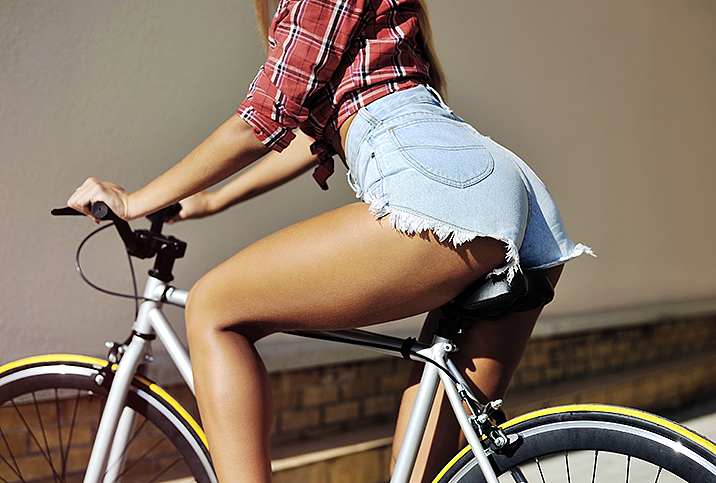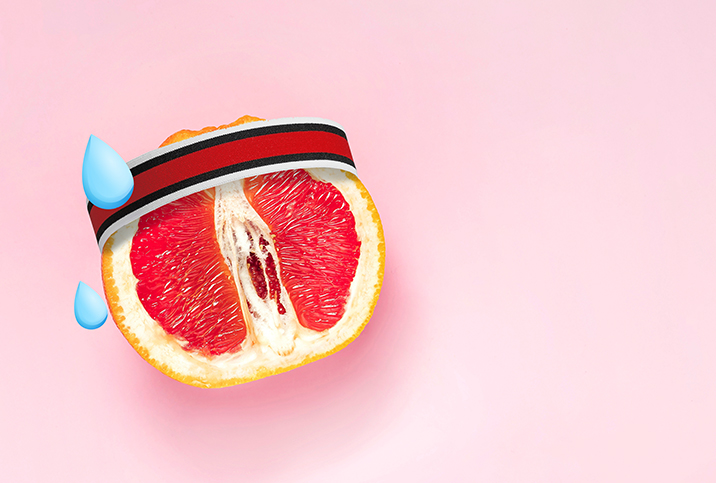The Right Bike Seat Height Can Change Your Sex Life

Cycling's popularity is for good reason. Among its touted benefits, pedaling improves cardiovascular health and muscular strength, and reduces stress. The rise of fitness technology, including electric bikes, has made it easier to work out at home. Plus, the mood-boosting outdoors is always beckoning us toward nature.
The global bicycle market was valued at $59.33 billion in 2021 and is expected to expand at a compound annual growth rate of 8.2 percent from 2022 to 2030.
For all the good cycling does, the wrong bike seat height and the exercise itself can actually produce a negative impact. A host of research points a finger at bikes wreaking havoc on your genitals and impacting sexual health and fertility. But many of the findings dismantle one another, and even true worries come with feasible solutions.
Health risks associated with cycling
A 2014 study in the Journal of Men's Health found no clear relationship between cycling, erectile dysfunction (ED) and infertility. Yet a more recent systematic review published in 2019 concluded cyclists are twice as likely to develop ED than non-cycling control patients.
So, what's the deal?
Simply said, prolonged time on the saddle may be more than your genitals bargained for. Men can experience a reduction in fluid released during ejaculation due to pressure on the prostate's blood and nerve supply, with such trauma potentially leading to urinary issues and, in rare cases, cancer, according to David Kimble, M.D., a board-certified urogynecologist at the Kimble Center in Southern California.
Although studies on the effects of cycling on women are limited, accounts of sexual organ damage, particularly in the vulvar region, have been noted, too. Occurrences of hematomas (blood collecting under the skin), vulvar lacerations, vulvar fibrosis and dysfunctional uterine bleeding (in the case of long-distance cycling) have also been recorded, Kimble said.
Female cyclists are more likely to experience urinary tract infections (UTIs) and genital numbness compared to swimmers and runners, suggests a 2018 study in the Journal of Sexual Medicine.
"What we know for sure is that hours of pedaling runs the risk of injury to genital nerves and lower oxygen levels in the muscles responsible for an erection," Kimble explained. "This is due to pressure on the perineum, which protects the pelvic floor muscles and vessels transporting blood to the genitals and urinary tract in men."
The perineum, located between the genitals and anus, supports the pelvic floor in both men and women. For women, intense bouts of cycling can reduce blood flow to the perineal arteries, causing vaginal numbness, fibrosis and pain during intercourse—a recipe to ravage your sex life.
"As the nerves to the clitoris are compressed during cycling, it can negatively impact a woman's ability to achieve an external or clitoral orgasm, similar to ED in males," Kimble said.
Cycling when trying to conceive
Although research often spotlights the hazards of cycling when trying to conceive, some experts shrug much of it off.
"I do not believe that all couples seeking pregnancy, where one or more partners cycle, should avoid getting on their bikes," said Michael Vance Homer, M.D., a reproductive endocrinologist at the Reproductive Science Center in the San Francisco Bay area.
Exercise is a sexual enhancement for many people, and a person can be harmed psychologically if they stop riding, leading to poorer reproductive outcomes, he added.
Cycling may be the boost your body needs to conceive.
"It's a fun exercise which gets your heart rate up and helps you maintain a healthy weight, all of which are essential to supporting fertility and getting the body ready to have a healthy pregnancy," said Alexis May Kimble, D.O., a board-certified urogynecologist at the Kimble Center.
The key is to balance your exercise routine and listen to your body's needs to avoid overdoing it.
Something else to keep in mind: Women in their second or third trimester of pregnancy should dial down the cycling due to a higher risk of falls and trauma, Alexis May Kimble said.
Reducing the risks
Research is often inconclusive, not to mention how far we've come in understanding how to negate the risks of cycling. Most of them subside once you hop off the saddle and cool down. Newly enhanced bicycle designs are also turning the wheels on traditional models to fashion cutting-edge bikes designed to mitigate real dangers to your nether regions.
Consider the following precautions if you want to be proactive about reducing your cycling risks:
Size up your saddle (and handlebars)
A wide saddle can decrease penile oxygen pressure to a significantly lesser degree (20.3 percent) than a traditional narrow design (72.4 percent), according to a 2020 review exploring the impact of cycling on the male perineum. The no-nose saddle was also found to effectively reduce urogenital numbness over a six-month period. To find your ideal saddle width, consider having your sit bones measured. Your ideal saddle size, at least for group road cycling, will be the width of your sit bones plus one inch. You may also consider using a saddle with a cutout to decrease pressure on the perineum.
However, note that the saddle that's best for you will largely depend on your riding position and style.
Women should pay more attention to handlebar height, as a study published in March 2012 in the Journal of Sexual Medicine suggested. Handlebars positioned lower than the saddle caused more perineal pressure and a decrease in genital sensation for females who cycle.
Give your privates a breather
Penile blood flow usually returns to normal values following 10 minutes of recovery from standing on the bike, said another finding from the 2020 review mentioned above.
As a rule of thumb, Kimble recommended standing for 25 percent of your cycling distance or possibly switching to a recliner bicycle, which encourages a new way of sitting without compression on the perineum.
Check your position
Your hips should remain steady and your knees modestly bent as you reach the furthest point in pedaling—the optimal position for reducing compression on the genital nerves. To steady your hips and prevent any seesaw-like movements, strengthen your core, find a proper bike fit, and adjust your saddle to the appropriate height.
As for your knees, when your foot is horizontal on the pedal at the six o'clock position, most road cyclists should maintain an angle of 140 to 145 degrees.
A slight downward tilt of the seat is another trick to reduce anterior compression on the saddle, according to a 2021 study published in the Journal of Functional Morphology and Kinesiology.
Pad up
Padded cycling shorts are a go-to item for enhancing comfort on the bike seat. With this supportive boost, force and pressure were found to decrease during a small, 20-minute cycling experiment conducted in Italy and published in the journal Medicine. Nine club road cyclists wore padded shorts of various foam densities and, interestingly, noted the shorts offering more perineal protection weren't the most comfortable.
It's hypothesized that comfort equates to more time on the saddle, resulting in extended pressure on your precious privates. Although padding may be one of the secrets to protecting your perineum, more research is required to say for sure.
Mix up your workouts
Listening to your body and adjusting exercise needs accordingly—be that duration, intensity or positioning—can greatly reduce perineal stress and keep your sex life on track. Release the load further by incorporating other forms of exercise.
"Workouts you can do to mimic the benefits of cycling include the elliptical machine, Stairmaster, power walking or swimming," said Cat Kom, an American Council of Exercise certified personal trainer, and CEO and founder of Studio SWEAT onDemand in San Diego.
"Combine this with bodyweight training exercises to strengthen the knee—such as step-downs and bench up and overs—and also to restore strength and correct imbalances you may have from pedaling with all that power," Kom added.
With the correct adjustment to bike seat height and the right approach to the sport, you can hit the pedals without worrying about cycling impacting your sexual health.


















